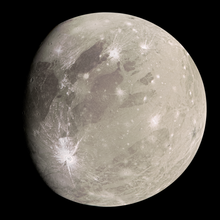It turns out that even though Ganymede has no atmosphere it is the 9th largest physical object in the solar system including the sun and likely has more water underground on Ganymede than all the oceans on earth combined! Wow!
Here's the thing. What do people need to breathe and to drink to stay alive? That's right! Oxygen and water. When people breathe out it's carbon dioxide. So, if you make underground caverns or caves by mining or using advanced laser techniques from this galaxy you have a lot of what you need to survive. Then if you have solar power from the sun on top of water and oxygen from the water you can also grow food underground too with grow lights if you wish.
What I'm saying here is there is likely much more water on Ganymede than on Mars simply because most of Mars' water likely evaporated out into space when the planet that is now the asteroid belt was blown up by our ancestors with nuclear weapons 65 million years ago. Most of Mars' atmosphere left then too along with most of their water. However, for some reason Ganymede's water has remained as Mars' evaporated?
I think I have more questions than answers here but some of you might go out as astronauts and find these answers one day on Ganymede and Mars.
Partial quote from:
https://en.wikipedia.org/wiki/Ganymede_(moon)
Ganymede (moon)
 Ganymede photographed by Juno in 2021 | |||||||||||||
| Discovery[1][2] | |||||||||||||
|---|---|---|---|---|---|---|---|---|---|---|---|---|---|
| Discovered by | Galileo Galilei | ||||||||||||
| Discovery date | January 7, 1610 | ||||||||||||
| Designations | |||||||||||||
| Pronunciation | /ˈɡænəˌmiːd/[3] GAN-ə-MEED | ||||||||||||
Named after | Γανυμήδης, Ganymēdēs | ||||||||||||
| Jupiter III | |||||||||||||
| Adjectives | Ganymedian,[4] Ganymedean[5][6] (/ˌɡænəˈmiːdi.ən/) | ||||||||||||
| Orbital characteristics | |||||||||||||
| Periapsis | 1069200 km[a] | ||||||||||||
| Apoapsis | 1071600 km[b] | ||||||||||||
| 1070400 km[7] | |||||||||||||
| Eccentricity | 0.0013[7] | ||||||||||||
| 7.15455296 d[7] | |||||||||||||
Average orbital speed | 10.880 km/s | ||||||||||||
| Inclination | 2.214° (to the ecliptic) 0.20° (to Jupiter's equator)[7] | ||||||||||||
| Satellite of | Jupiter | ||||||||||||
| Group | Galilean moon | ||||||||||||
| Physical characteristics | |||||||||||||
Mean radius | 2634.1±0.3 km (0.413 Earths)[8] | ||||||||||||
| 8.72×107 km2 (0.171 Earths)[c] | |||||||||||||
| Volume | 7.66×1010 km3 (0.0704 Earths)[d] | ||||||||||||
| Mass | 1.4819×1023 kg (0.025 Earths)[8] | ||||||||||||
Mean density | 1.936 g/cm3 (0.351 Earths)[8] | ||||||||||||
| 1.428 m/s2 (0.146 g)[e] | |||||||||||||
| 0.3115±0.0028[9] | |||||||||||||
| 2.741 km/s[f] | |||||||||||||
| synchronous | |||||||||||||
| 0–0.33°[10] | |||||||||||||
| Albedo | 0.43±0.02[11] | ||||||||||||
| |||||||||||||
| 4.61 (opposition)[11] 4.38 (in 1951)[12] | |||||||||||||
| 1.2 to 1.8 arcseconds | |||||||||||||
| Atmosphere | |||||||||||||
Surface pressure | 0.2–1.2 μPa (1.97×10−12–1.18×10−11 atm)[15] | ||||||||||||
| Composition by volume | mostly oxygen[15] | ||||||||||||
Ganymede, a satellite of Jupiter (Jupiter III), is the largest and most massive of the Solar System's moons. The ninth-largest object (including the Sun) of the Solar System, it is the largest without a substantial atmosphere. It has a diameter of 5,268 km (3,273 mi), making it 26 percent larger than the planet Mercury by volume, although it is only 45 percent as massive.[16] Possessing a metallic core, it has the lowest moment of inertia factor of any solid body in the Solar System and is the only moon known to have a magnetic field. Outward from Jupiter, it is the seventh satellite and the third of the Galilean moons, the first group of objects discovered orbiting another planet.[17] Ganymede orbits Jupiter in roughly seven days and is in a 1:2:4 orbital resonance with the moons Europa and Io, respectively.
Ganymede is composed of approximately equal amounts of silicate rock and water. It is a fully differentiated body with an iron-rich, liquid core, and an internal ocean that may contain more water than all of Earth's oceans combined.[18][19][20][21] Its surface is composed of two main types of terrain. Dark regions, saturated with impact craters and dated to four billion years ago, cover about a third of it. Lighter regions, crosscut by extensive grooves and ridges and only slightly less ancient, cover the remainder. The cause of the light terrain's disrupted geology is not fully known, but was likely the result of tectonic activity due to tidal heating.[8]
end partial quote.
No comments:
Post a Comment